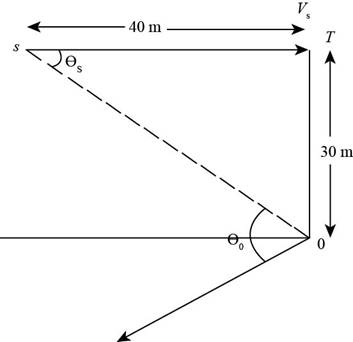
Concept explainers
(a)
The frequency heard by the passengers in the car.
(a)
Answer to Problem 17.71CP
The frequency heard by the passengers in the car is
Explanation of Solution
Given info: The speed of the train is
Consider the following figure.

Figure (1)
In right angle triangle
Substitute
The value of the
In triangle
Substitute
The value of the
The expression for the frequency heard by the passengers in the car is,
Here,
Substitute
Conclusion:
Therefore the frequency heard by the passengers in the car is
(b)
The range of frequencies heard by the passenger in the car.
(b)
Answer to Problem 17.71CP
The range of frequencies heard by the passenger in the car is
Explanation of Solution
Given info: The speed of the train is
Since the observer and source are moving away from each other so the value of the angles becomes equal to zero.
The expression for the frequency heard by the passengers in the car is,
For the case when the train is arrived:
Substitute
For the case when train is arriving:
Substitute
Conclusion:
Therefore the range of frequencies heard by the passenger in the car is
(c)
The frequency heard by the passengers in the car.
(c)
Answer to Problem 17.71CP
The frequency heard by the passengers in the car is
Explanation of Solution
Given info: The speed of the train is
The expression for the frequency heard by the passengers in the car is,
Substitute
Conclusion:
Therefore the frequency heard by the passengers in the car is
Want to see more full solutions like this?
Chapter 17 Solutions
EBK PHYSICS FOR SCIENTISTS AND ENGINEER
- Can someone help me with this question. Thanks.arrow_forwardIdentical rays of light enter three transparent blocks composed of different materials. Light slows down upon entering the blocks.arrow_forwardFor single-slit diffraction, calculate the first three values of (the total phase difference between rays from each edge of the slit) that produce subsidiary maxima by a) using the phasor model, b) setting dr = 0, where I is given by, I = Io (sin (10) ². 2arrow_forward
 Principles of Physics: A Calculus-Based TextPhysicsISBN:9781133104261Author:Raymond A. Serway, John W. JewettPublisher:Cengage Learning
Principles of Physics: A Calculus-Based TextPhysicsISBN:9781133104261Author:Raymond A. Serway, John W. JewettPublisher:Cengage Learning University Physics Volume 1PhysicsISBN:9781938168277Author:William Moebs, Samuel J. Ling, Jeff SannyPublisher:OpenStax - Rice University
University Physics Volume 1PhysicsISBN:9781938168277Author:William Moebs, Samuel J. Ling, Jeff SannyPublisher:OpenStax - Rice University
 Physics for Scientists and Engineers: Foundations...PhysicsISBN:9781133939146Author:Katz, Debora M.Publisher:Cengage Learning
Physics for Scientists and Engineers: Foundations...PhysicsISBN:9781133939146Author:Katz, Debora M.Publisher:Cengage Learning Physics for Scientists and Engineers with Modern ...PhysicsISBN:9781337553292Author:Raymond A. Serway, John W. JewettPublisher:Cengage Learning
Physics for Scientists and Engineers with Modern ...PhysicsISBN:9781337553292Author:Raymond A. Serway, John W. JewettPublisher:Cengage Learning Physics for Scientists and EngineersPhysicsISBN:9781337553278Author:Raymond A. Serway, John W. JewettPublisher:Cengage Learning
Physics for Scientists and EngineersPhysicsISBN:9781337553278Author:Raymond A. Serway, John W. JewettPublisher:Cengage Learning





